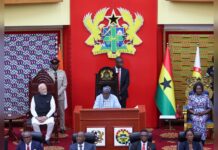Despite a comparatively strong social protection framework, less than one percent of the nation’s Gross Domestic Product (GDP), since 2015, is spent on such interventions, a recently-released mirror report by SEND Ghana, has found.
The report, which follows a study conducted in partnership with the Ghana Civil Society Partnership on Social Accountability for Social Protection, seeks to provide a complementary and comprehensive evaluation of official government reports with the view to promoting mutual accountability in the implementation of social protection intervention.
It showed that Ghana falls behind its Lower-Middle Income peers in Sub-Saharan Africa (SSA) who spend approximately 2.2 percent of GDP in this regard. Unsurprisingly, the nation’s social protection expenditure pales in comparison to the middle-income range, which the United Nations Children’s Fund (UNICEF) indicates is between 6.7 percent and 8.7 percent.
Speaking with the B&FT at the launch of the report in Accra, Programmes Officer of SEND Ghana, Dr. Isaac Nyarko Kwakye, explained that, unlike previous reports which have been presented from the view of supply-side actors – government, development partners and CSOs, this report prioritised the beneficiaries, with 1,496 respondents from the 10 ‘traditional’ regions.
“The importance of social protection interventions necessitated the development of the Social Protection Accountability Framework to enable the collection of data on the flagship programmes from the perspective of the beneficiaries to see if what the government is saying is consistent with their experience,” he said.
He stated that sizeable variance between approved budgetary allocations and disbursements represents the biggest challenge for the five flagship programmes – Capitation Grant (CG), Labour Intensive Public Works (LIPW), National Health Insurance Scheme (NHIS), Ghana School Feeding Programme (GSFP) and Livelihood Empowerment Against Poverty (LEAP).
The NHIS has received the highest allocation relative to GDP. However, analysis shows that the Scheme is bedeviled with liquidity challenges because not all the revenue generated from the NHIS-focused levy is credited to the relevant Fund.
“We continue to see a sharp variance between what is allocated and what is made available to relevant agencies for onward disbursement. In some instances, they receive far less – less than 50 percent – of what was allocated and that is a big problem,” Dr. Nyarko Kwakye said, adding that frequent delays in disbursements, logistic constraints and seeming politicisation are beginning to erode public confidence in the effectiveness of the programmes.
The report called for an enhancement of data collection under the Ghana National Household Registry (GNHR) to create a single register, saying the programmes would become more efficient and effective if the targeting and selection criteria for potential beneficiaries is enhanced.
It also recommended the fast-tracking of the Social Protection Bill by the Ministry of Gender, Children and Social Protection for submission to Parliament.
“The Bill prescribes robust and effective institutional oversight, financial framework coordination and partnerships for sustainable and effective implementation of social protection,” it explained.
It further called for a gradual increase in social protection spending to 4.5 percent of GDP by 2025.
“Human resources have always been important but it has gained added importance as we shift toward a new way of working. If we fail our people by not giving the most vulnerable adequate social protection and safety nets. We will not only lose economic potential but we could have health and security issues on our hands,” Dr. Nyarko Kwakye warned.










